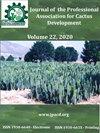摩洛哥仙人掌品种(Karama、Ghalia、Belara、Marjana、Cherratia、Angad和Melk Zhar)对cochineal Dactylopius opuntiae (Cockerell)抗性的形态和物候特征
IF 0.4
4区 农林科学
Q4 HORTICULTURE
Journal of the Professional Association for Cactus Development
Pub Date : 2023-07-24
DOI:10.56890/jpacd.v25i.519
引用次数: 0
摘要
近年来,摩洛哥的仙人掌栽培受到了大翅目仙人掌科(Dactylopius opuntiae, Cockerell)(半翅目:大翅目仙人掌科)的严重威胁,经研究鉴定出对该虫具有抗性的仙人掌梨品种4种8个,已在摩洛哥官方种、变种目录中登记。利用Karama、Ghalia、Belara、Marjana、Cherratia、Angad和Melk Zhar这8个品种的20个形态特征进行了形态学和物候学表征。主成分分析允许根据研究特征区分五组。Aakria具有最小的鲜红色果实和非常小的枝(15.8/7.7厘米),Belara具有最高的枝数(101.2),大枝(36.4/25.8厘米)和非常甜的大黄绿色果实,Marjana具有非常厚的枝(2.3厘米)和大而非常甜的果实。品种组(Melk Zhar, Angad和Cherratia)的特点是枝部宽且多刺,刺最长,果实大(202.5- 276.7 g)。品种组(Karama和Ghalia)的特点是枝部大(33.4-36.0/16.4-25.6 cm),果实中等大小(98.5-115.6 g)。此外,Aakria的营养萌发和开花时间最长,Marjana的最短。果实发育时期以阿克瑞亚最长,玛尔迦那最短。综上所述,这些形态和物候上的差异在摩洛哥被鉴定为对机会夜蛾具有抗性的8个仙人掌梨品种中可以作为育种计划的主题。本文章由计算机程序翻译,如有差异,请以英文原文为准。
Morphological and phenological characterization of Moroccan Opuntia cactus varieties (Karama, Ghalia, Belara, Marjana, Cherratia, Angad, and Melk Zhar) resistant to the cactus cochineal Dactylopius opuntiae (Cockerell)
In recent years, Opuntia cactus cultivation has been seriously threatened by the appearance of Dactylopius opuntiae (Cockerell) (Hemiptera: Dactylopiidae) in Morocco, and four species with eight cactus pear varieties have been identified by research as resistant to this cochineal, these varieties are already registered in the official catalog of species and varieties in Morocco. A morphological and phenological characterization using twenty morphological attributes of these eight varieties: Karama, Ghalia, Belara, Marjana, Cherratia, Angad, and Melk Zhar were performed. The principal component analysis allowed distinguishing five groups according to the studied characteristics. Aakria with the smallest bright red fruit and very small cladodes (15.8/7.7 cm), Belara with the highest number of cladodes per plant (101.2), large cladodes (36.4/25.8 cm) and very sweet large yellow-green fruit, Marjana with very thick cladodes (2.3 cm) and large and very sweet fruit. The group of varieties (Melk Zhar, Angad and Cherratia) is characterized by wide and thorny cladodes, the longest thorns and fruits of large size (202.5- 276.7 g). The group containing the varieties (Karama and Ghalia) is characterized by large cladodes (33.4-36.0/16.4-25.6 cm) and medium size fruits (98.5-115.6 g). Also, the periods of vegetative and floral budding, and flowering were the longest for Aakria and the shortest for Marjana. The period of fruit development was the longest for Aakria and the shortest for Marjana. In conclusion, these morphological and phenological variations among the eight cactus pear varieties identified as resistant to D. opuntiae in Morocco could be the subject of breeding programs.
求助全文
通过发布文献求助,成功后即可免费获取论文全文。
去求助
来源期刊

Journal of the Professional Association for Cactus Development
Agricultural and Biological Sciences-Plant Science
CiteScore
1.10
自引率
33.30%
发文量
10
期刊介绍:
The editors of the Journal of the Professional Association for Cactus Development, are very excited to be a part of the excellent editorial committee and to work together to create the synergism between scientists, growers, legislators, and business people so vital to the development of this industry to serve the people of arid lands.
 求助内容:
求助内容: 应助结果提醒方式:
应助结果提醒方式:


